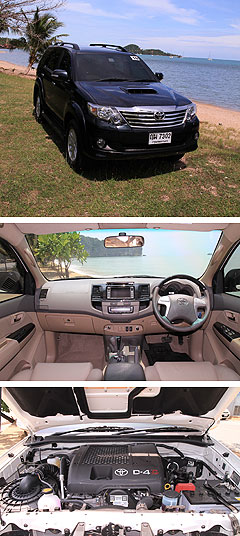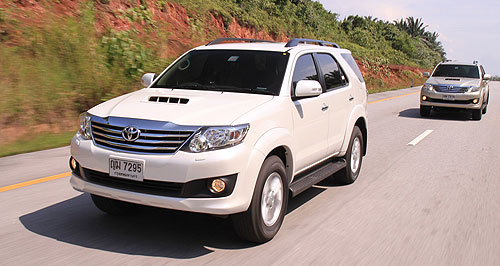News - Toyota - FortunerAussie Toyota engineers working on SUVHands full: Toyota Australia engineers are responsible for the development of the next Fortuner SUV, alongside their work on vehicles such as the Camry and Aurion. Key role for Toyota Australia in development of next-gen HiLux-based Fortuner SUV19 Apr 2012 TOYOTA Australia is developing the next generation of the HiLux-based SUV, the Fortuner, joining rivals Ford and Holden in major model development roles within their global design and engineering organisations. The company was responsible for the design facelift for the current Fortuner, which is built in Thailand and sold in developing markets such as Asia, the Middle East and South America. Now Toyota Technical Centre Australia (TTCAu) will responsible for development of the all-new SUV from the point where the project diverges from the HiLux on which it is based. As GoAuto has reported, Toyota Australia engineers will also lead chassis tuning of the HiLux. The next Fortuner brings the number of ute-based SUVs being developed in Australia to two, the other based on Ford’s locally-developed T6 Ranger platform and expected to be called Everest when it hits the streets. In addition, Holden this week announced it had been asked to develop two General Motors cars for the Chinese market. At the recent launch of Toyota’s second-generation Aurion large car, TTCAu assistant general manager of body engineering, Gerald Kent, told GoAuto the organisation was “attempting to embed ourselves into the development (of overseas vehicles like the Fortuner) earlier and earlier”.  He explained that in addition to its contribution to the development of the locally-built, internationally-sold Camry and Aurion sedans, the Fortuner is another large vehicle responsibility for TTCAu, the three models accounting for about 50 per cent of its workload. Mr Kent said he worked on the Aurion’s upper body in Japan alongside Thai and Japanese engineers in order to establish a collaborative relationship so that TTCAu and Toyota Motor Asia Pacific Engineering and Manufacturing (TMAP-EM) could work on future vehicle development projects together. “The IMV (HiLux/Fortuner) is an extension of that,” he said. “TMAP-EM will be responsible for the double-cab and we will take responsibility for the SUV where the vehicles start to diverge. “At the moment we are working very closely and are interlinked with each other.” Describing TTCAu’s relationship with TMAP-EM as symbiotic, Mr Kent said his team was also supporting 17 engineers in Japan that were working on the next-generation HiLux/Fortuner project. He said the purpose of TTCAu management visits to Thailand was to explore “further opportunities for this symbiotic relationship”. “We have ongoing discussions on a regular basis and there are certainly a number of projects that we are currently doing in collaboration and are constantly looking to expand that relationship,” he said. “In principle our objective moving forward is to utilise our two types of strengths in order to proceed with vehicle development.” Mr Kent welcomed the streamlined product development structures pioneered at Lexus and recently extended to Toyota, with a side-effect of new regional research and development bases placing Australia in the same basket as Russia, the Middle East, Latin America, Africa and Asia (excluding China). He said TTCAu hoped the move will result in more international development business but that no firm commitments had yet been made. “We obviously need to level our workload,” he said, adding that TTCAu’s engineers were highly regarded as a resource available to Toyota globally. “Leveraging that has to make sense from a local, regional and global level based on the total company’s workload balance,” he said. Mr Kent said TTCAu’s role was diverse and in addition to his body engineering department, the organisation played a large part in the development of integrated electronic systems such as blind-spot monitoring and adaptive headlights as fitted to the Camry and Aurion. “As the level of electronic integration becomes more important in Australia, we will take on roles to ensure vehicles that are coming here will conform,” he said. “On top of that there is suitability testing for four-wheel-drives so there are numerous things we are doing apart from simply vehicle development or current production support. “It comes down to where we can add value globally to our parent company.” As Toyota Australia has its medium SUV bases covered with the Kluger and Prado, the Fortuner is unlikely to be sold here, and it is not yet clear if Ford’s Everest is destined for Australian showrooms. Confirmed for Australia however, is the Holden Colorado 7 – a successor to the Jackaroo – that is scheduled to arrive in the first quarter of next year as a contender against similarly rugged body-on-frame SUVs like the Toyota Prado, Nissan Pathfinder and Mitsubishi Challenger. Isuzu Ute Australia is eyeing its own SUV version of the new D-Max, known in Thailand as the MU7, but nothing has yet been confirmed.  Read more10th of April 2012  Toyota streamlines product developmentAkio Toyoda slices through Toyota bureaucracy to put excitement first29th of December 2011  Ford set to scale EverestRanger-based SUV wagon named as Everest in Ford Australia test web page11th of November 2011  First look: Holden confirms Colorado SUVSpiritual successor to the Holden Jackaroo SUV to be called Colorado 7 in Australia22nd of September 2011  Aussie auto designers plug in to global productsDesign software helps to propel Australian automotive expertise to world via web7th of September 2011  Next Toyota HiLux to get Aussie touchToyota Australia engineers to lead chassis tuning for next-generation HiLux |
Click to shareToyota articlesResearch Toyota Fortuner pricingMotor industry news |
















Facebook Twitter Instagram